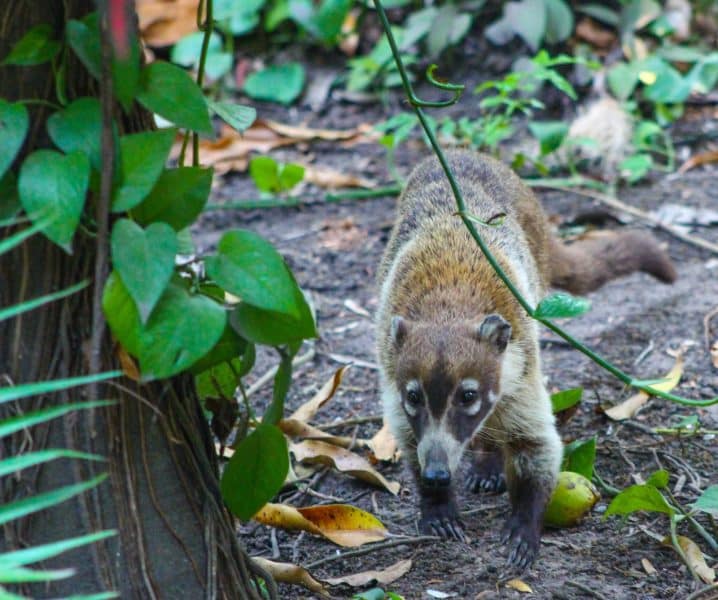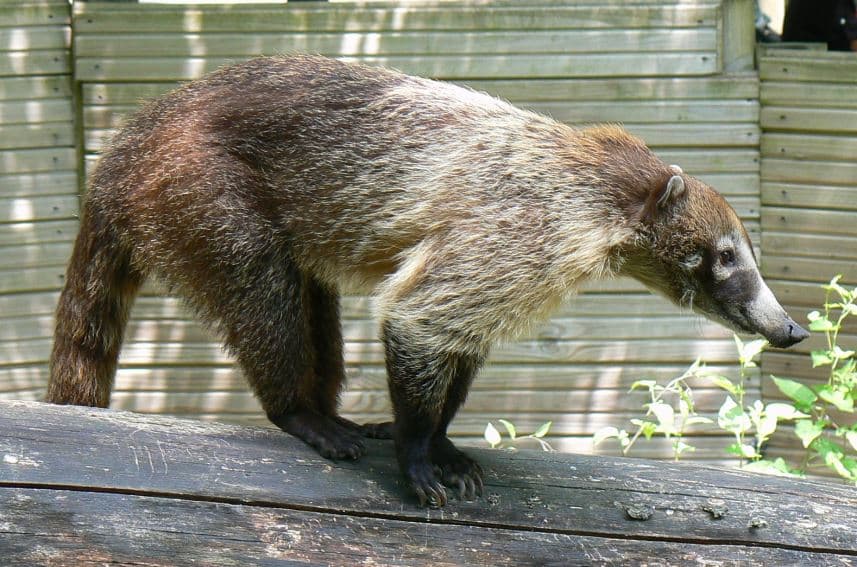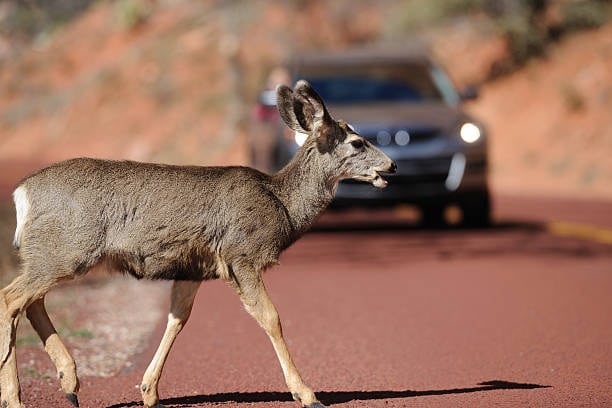Everything You Need to Know About Coati Animal
Do you want to know interesting facts about the Coati animal? Coati is a tree-climbing mammal belonging to the raccoon family. They are mostly daily and cross between a lemur, monkey, and raccoon. These furry creatures weigh up to 6 to 18 pounds and can reach up to 27 inches in length.
Coatis have strong jaws, an elongated snout, slender bodies, small ears, bear-like paws, and a long bushy tail. When they sense any danger, they become aggressive and use their long claws and sharp teeth to protect themselves. In the wild, coatis can live for 7 to 8 years, and in captivity, they survive up to 15 years due to better living conditions. They like to rest or sleep in elevated places such as the rainforest canopy and sleeping nests.
Let’s look at the habitat, diet, appearance, behavior, lifespan, and other interesting details of Coati animals.
Unveiling the Important Details About Coatis

Coatis are mobile omnivores native to Central and South America and the Southern USA. They are also known as coatimundis and belong to the family Procyonidae. They have double-jointed ankles and powerful claws, allowing them to walk on vertical surfaces. Coatis are adaptable and can live in different areas, from hot and arid rainforests to grasslands and cold mountain ranges.
They have an excellent sense of smell that they often use to find food. Their long tail, swiveling ankles, and powerful claws make them adept climbers. Unlike many other animals, they can stand on their hind legs briefly. Their forelimbs are so strong that they can easily dig into crocodile nests, overturn large stones, and rip apart decaying logs in search of food.
There are four different kinds of coati species- the white-nosed coati found in New Mexico, Arizona, and northwest Colombia; the South American coati found in Uruguay and north Argentina; the western mountain coati found in the Ecuadorian and Colombian Andes; and the eastern mountain coati found in the Venezuelan Andes. Coatis are closely related to raccoons and exhibit similar behavior to them. But unlike raccoons, they stay awake during the day.
Fun Facts About Coati Animal
- Coatis play an important role in maintaining their habitat’s regenerative ability. They transport and ingest the seeds of forty-nine different plant species. So protecting coatis becomes very important to ensure the longevity of their habitat.
- Even though there are four different varieties of coatis, not all of them are well-known to humans as they are not commonly encountered. The eastern and western mountain coati, which inhabit high-altitude cloud forests, remain mysterious.
- Male coatis leave their group once they mature and adopt a solitary lifestyle. They only join large groups during the breeding season for a few weeks. Once the breeding season is over, they like to stay alone.
- Coatis are very friendly and exhibit various social behaviors, including nursing, vigilance, cooperative grooming, and defensive behavior. When one band meets another band, they show aggressive behavior towards each other. However, intergroup grooming sessions also occur rarely within their groups.
- Coatis are excellent climbers and good swimmers. They spend most of their time on the ground but give birth on trees. After mating, the female coati builds a sturdy tree nest where she spends most of her gestation period. After giving birth, the female coati rejoins the band with her baby.
- They are opportunistic eaters, and their diet keeps changing throughout their lives. They mostly feast on grubs, beetles, and termites, but they can also eat fruits and small vertebrates like mice, frogs, lizards, and even dead animals when they don’t get their preferred food.
- Female coatis live in large groups with their babies. The group includes 20-30 members at a time and is called a band. When the male babies are two years they leave the group, while the female babies spend the rest of their lives in the band. Males rejoin the band during the mating season. The bands are very noisy, with constant snorts and chirps.
- Prey can’t hide from coatis as they have an excellent sense of smell. The elongated nose of coatis helps them locate hidden prey. They love food so much that they even dig into crocodile nests to find prey.
- A unique fact about the coati animal is that it can stand bipedally. Though they walk quadrupedally, most of the time, they can stand on their two hind legs when required. They usually stand on their two hind legs to have a clear view of their prey and to get food.
Appearance and Behavior of Coati Animal

Coati animals have a long snout that helps them look for fruit and insects. They mostly have brown-colored fur and a tail similar to a lemur. Their double-jointed ankles and powerful paws help them to easily climb up and down objects like trees, rocks, etc. Their fur is of different colors ranging from white to black, red, and light brown, with light facial markings and lighter underparts. Their flexible and long snout has a white band near the tip. Coatis can rotate their pig-like snout in all directions. The double-jointed ankles of coati can spin backward and offer excellent grip when climbing trees.
The male coati measures about 29 to 54 inches and weighs roughly 10 to 24 pounds. The tail of the male coati animal is very long. The female is smaller in length. The semi-prehensile, long, muscular tail of the coat helps it balance in the trees. When the coati is on the ground, its tail is mostly straight, helping them watch over each other in the dense, lush green vegetation.
Coatis are very social and prefer to live in bands. Males live in the band until they become adults. Females live in the pack throughout their lives. The only time a female coati leaves her group is during the gestation period and when she has to give birth to her baby. Once she gives birth to her baby, she rejoins the group and her baby. A group of coatis travel huge distances searching for food. The band members watch over predators and alert each other when they sense danger.
Like cocoons, coatis are excellent climbers. They are omnivores and like to eat insects, lizards, fruit, grubs, small birds, and carrion. Coatis are diurnal and remain active during the daytime. They are highly intelligent, adaptable, and have a great sense of smell. They root the ground using their snout in a pig-like manner to locate invertebrates. Coatis like to make different types of noises, like chirping and snorting. They alert other members about potential dangers and express their mood using these noises.
Reproduction, Babies, and Lifespan
Coatis follow a polygynous mating system. The male joins the band of juveniles and females during the breeding season. Whether the male will be accepted in the group or not is decided by the females. Coatis follow a polygynous mating system wherein one male forms a relationship with many females. Once the female becomes pregnant, she leaves the group and builds a sturdy tree nest where she resides until she gives birth to her baby.
The gestation period lasts around eleven weeks. After eleven weeks, female coati gives birth to litters of 3-7 kits. The female rejoins the band with her young one six weeks after birth. Male coati remain in the group until maturity, while female coati remain lifelong. At around 18 months, coatis reach sexual maturity. The young ones are born blind and are weaned at six months.
In the wild, coatis can live for 7 to 8 years, and in captivity, they survive up to 15 years due to better living conditions.
Reasons Why Coatis Don’t Make Good Pets

Coatis look cute as kittens, but as soon as they reach adulthood, they become very aggressive. It’s not a good idea to keep coatis as pets as they are violent and dangerous. Male coatis are more aggressive and dangerous than females. There have been countless cases of unwanted incidents like the destruction of furniture and severe bites in the past. You should not have them as pets if you can’t handle their sharp claws and teeth. Many people get coatis claws and teeth removed to safeguard their family against any potential danger, but this is very inhumane, and you should never do this.
Coatis are wild animals and prefer living in an open environment rather than enclosures. If you still want to have them as pets, you need to ensure you provide them with the ideal environment they get in the wild. It is very important to provide them with the correct diet, the right housing, and ample time to fulfill their needs. Never allow your kids to play with coatis as they can bite them and cause severe injury. If you don’t socialize and bottle-raise coatis at a young age, they will become very dangerous and violent. While handling the coati animal, you should always wear protective, thick gloves to prevent scratches or injuries from scurrying coati.
Coati mundi animals should be kept in large outdoor and indoor enclosures. The enclosure should be at least ten feet. You can also repurpose a walk-in aviary that you previously used for wild birds, parrots, or small flocks. Equip the enclosure with climbing areas and toys to keep your coatis active and engaged. If you prefer putting your coati on a leash and taking it outside for a walk, be very careful, as it may become stubborn and refuse to follow your instructions. Indoors, it would help if you never kept a coati loose as it may injure itself and damage your home.
Coatis prefer mealworms, crackers, cereals, and gut-loaded crickets. You can also give them prickly pear fruits as a training reward. You should never give overly salty or sweet foods to your coati. Your coat may develop diseases related to food aggression, poor diets, or picky eating if you spoil it with these foods.
If you’re thinking about keeping a coati as a pet, then you must check the state laws of your country. It is not legal to keep coatis as pets in all countries. It is allowed in most South American nations but not in European countries like Spain.
What is the Difference Between Coatimundi and Coati?
Both coatimundi and coati are used interchangeably to refer to Procyonidae, a group of mammals from the raccoon family. Coatimundi is a commonly used word in South and Central America, while Coati is a widely used term in North America. Coatimundi is the other name of the coati but is most commonly used to refer to a specific coati species known as the white-nosed coati.
Are Coatis Social Creatures?
Coatis are social creatures that prefer to live in groups called bands. Bands comprise younger males and females. They live in bands of up to 30 members and are quite affectionate towards each other. The band comprises both non-biological and biological relatives, and the old female members take turns watching for predators and babysitting while other mothers forage.
When male coatis reach maturity, they leave their band and start living a solitary life. They rejoin the group during the breeding season for a few weeks to mate with the female members. When females get pregnant, they move out of the band and spend their entire gestation period in a sturdy tree nest. If they spot a predator, they rally together to scare and drive away their attacker.
What are the Threats to Coati’s Survival?
Predators are one of the biggest threats to Coati’s survival. As they spend lots of time on the ground, they often fall victim to predators like cats, such as jaguarundi, jaguars, or ocelots, and canines like the domestic dog and maned wolf. Birds of prey and large, constricting snakes also threaten coati’s survival. Humans also hunt coatis on an extensive scale for their meat and fur. Loss of habitation and deforestation are the greatest threats to Coati’s survival. The destruction of their habitat has decreased their survival rate because it has become easier to find them in rainforests in smaller fragments.
Conclusion
Coatis may look cute, but they are very aggressive and dangerous. They can bite humans and damage their property, so you should be very careful if you’re planning to keep them as pets. Coatis are very adaptable and can live in different kinds of habitats. They feed on various foods, including small animals, insects, and fruit. Male coatis are solitary, while females live with their babies in bands comprising 10 to 30 animals.
Coatis can remember sequences of actions and solve complex problems, making them one of the most intelligent animals. You can check out the facts mentioned above if you want to know more about the behavior, diet, habitat, appearance, and lifespan of these creatures.
This will make your coati ownership a rewarding experience.
Frequently Asked Questions
Are Coatis Dangerous?
Adult coatis are very aggressive and may bite humans or injure them. Since they are wild animals, they may not adjust to the indoor environment and become even more violent. There have been countless cases of unwanted incidents like the destruction of furniture and severe bites in the past.
What is the Importance of a Coati’s Tail?
Coatis use their banded and long tails as balancing poles while climbing. When they are on the ground, their muscular tails are straight up to keep track of one another in the vegetation. Coatis also use their tail for gripping.
Can You Keep a Coati as a Pet?
If you’re planning to keep a coati as a pet, then you must check the state laws of your country. It is not legal to keep coatis as pets in all countries. Coatis are also very aggressive and can bite you if you don’t know how to handle them.
Where are Coatis Found?
Coatis are found in the southwestern United States, Uruguay, and northern Argentina. They can survive across various habitats, including mountain slopes, rainforests and grasslands
What Should You Keep in Mind While Purchasing a Coati Animal?
It would be best never to adopt coati from the wild as it can pose immense danger to you and your family. Find a reputable breeder who can help you buy the coati. When you visit the breeder, try to spend time with the coati to know how social and well-behaved it is.







